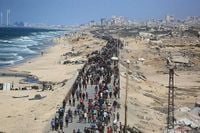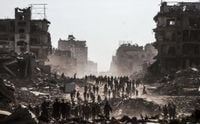On October 10, 2025, a fragile calm settled over the Gaza Strip as a long-awaited ceasefire between Israel and Hamas took effect. For the first time in two years, the relentless thud of artillery and the drone of warplanes gave way to the sounds of footsteps, voices, and the rumble of trucks as hundreds of thousands of displaced Palestinians began the arduous journey home. But what awaited them was not the comfort of familiar walls and bustling neighborhoods—it was devastation on a scale few could have imagined.
According to The Associated Press, entire neighborhoods in Gaza City, Zeitoun, Khan Younis, and Sheikh Radwan lay in ruins. Palestinian families, their belongings piled onto trucks, donkey carts, or balanced precariously on their heads, moved through streets flanked by the skeletal remains of buildings and mountains of rubble. The AP captured haunting images: a young girl carrying a bag on her head, an elderly woman navigating shattered streets, and families waving Egyptian and Palestinian flags as they returned to what was left of their homes. Israeli soldiers, meanwhile, stood guard near tanks along the border, a stark reminder that the war’s end was uneasy and incomplete.
The ceasefire, brokered after two years of brutal conflict, included the release of the remaining hostages, a move that brought a measure of relief but also underscored the immense cost of the war. Nearly half a million displaced Palestinians rushed northward, reported IMEMC News, only to discover that their houses had been obliterated by Israeli bombardment and demolitions. The once-fertile farmland, famous for olives and strawberries, was now reduced to ash and toxic dust. The air reeked of burning plastic, the soil glowed with unexploded metal, and the sea was slick with sewage—a scene of environmental devastation as much as humanitarian tragedy.
Mahmoud Basal, spokesperson for Gaza’s Civil Defense Agency, told Mada Masr that most of Gaza City’s north, east, and southern neighborhoods were almost completely destroyed. "The campaign that began in mid-August has razed tens of thousands of homes to the ground," Basal stated, estimating that around 300,000 people had already made the journey back northward. The United Nations, in a preliminary analysis, found that 83 percent of structures—about 81,000 housing units—in Gaza City had been damaged.
For many, the return was bittersweet, tinged with heartbreak and regret. Emad Azzam, who had been displaced twice since the war began, arrived at the site of his former home in Sheikh Radwan only to find "a pile of rubble." Speaking to Mada Masr, he confessed, "I wish I hadn’t come back." He and his family had scraped together what little they had to flee south, enduring overcrowded and underserviced conditions in Khan Younis. When the ceasefire began, hope led them back north, but reality was crushing. "I couldn’t help but hope," Azzam said, "but I knew deep down that my home and my family’s home had been destroyed."
Others found fragments of hope amid the ruins. Saady Mhanna, returning to Tal al-Hawa in southern Gaza City, discovered that while most of his house was destroyed, part of it could be repaired. "Thank God, part of it could be repaired so we can live there until reconstruction begins," Mhanna told Mada Masr. He planned to return to Khan Younis to bring his family home.
Yet, for thousands more, the idea of returning was futile. Um al-Abd al-Hamalawy, whose family’s home in Jabalia camp was destroyed, remained in a tent in the Zuwayda area west of central Gaza. "We walk on foot from the south to the north, just to see the ruins of our homes and our lives," Hamalawy said. The lack of tents or temporary housing, as Basal noted, meant that many returnees had nowhere to stay. The Israeli military had not allowed enough tents or prefabricated houses through the crossings, and the cost of buying a tent and renting land was prohibitive for most families.
Despite the scenes of return—both triumphant and tragic—many Palestinians remained wary. Israeli troops were still deployed across much of the enclave, and the military continued to bar residents from approaching designated zones, particularly in Beit Hanoun, Beit Lahia, Shujaiya, and parts of Khan Younis and near the Rafah crossing. Ahead of the ceasefire, US President Donald Trump released a map showing an "initial withdrawal line," and Israeli media reported that the military had begun pulling back in line with this plan. The withdrawal, discussed at a ceasefire summit in Sharm el-Sheikh, Egypt, was expected to cover around 35 percent of the 85 percent of Gaza previously occupied by Israeli forces—only after the first phase of a prisoner exchange with Hamas.
The ceasefire agreement also stipulated that aid provision would resume at levels set during a brief truce in January. The United Nations called for 600 trucks to enter Gaza daily to meet the needs of two million people, including urgent care for around 200,000 suffering from malnutrition. However, as of mid-October, aid was slow to arrive, and resources for shelter and survival in northern Gaza remained scarce.
Complicating the fragile peace, IMEMC News reported that clashes continued in Gaza City between Israeli-backed gangs and internal security forces, even after the ceasefire announcement. During the conflict, Israel had allegedly armed and supported several collaborator groups to sow chaos and target resistance members. With the withdrawal of Israeli forces, officials stated that these gangs—such as the ‘Abu Shabab’ group—would be left to fend for themselves.
For many in Gaza, the end of active fighting did not mean the end of hardship or fear. Since the collapse of an earlier ceasefire in March, more than 1.2 million people had been displaced, according to the UN. The scale of known destruction, the ongoing military presence, and the lack of basic necessities made the journey home for many a leap of faith—and for some, an act of desperation.
Jared Kushner, advisor to President Trump, celebrated the "end of the war" in remarks from Tel Aviv. But for families like the Hamalawys, the sentiment rang hollow. "What war has stopped?" Hamalawy asked. "We’re living through a thousand wars. They took our lives and gave us a tent, and they want us to be joyous because they’ve stopped the killing and destruction."
As bulldozers began clearing rubble in Gaza City, the world watched and waited. The upcoming ceasefire summit in Sharm el-Sheikh, with President Trump expected to attend, offered a glimmer of hope for a more lasting peace. But for the people of Gaza—returning to ruins and facing an uncertain future—the road to recovery, both physical and emotional, remains long and fraught with challenges.
In the shadow of devastation, the resilience of Gaza’s people endures, even as they mourn what has been lost and brace for the hard work of rebuilding their lives from the ground up.



